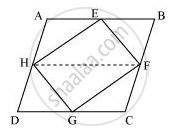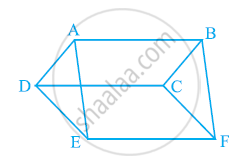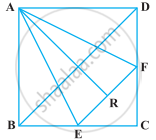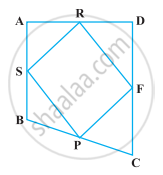Advertisements
Advertisements
प्रश्न
If E, F, G and H are respectively the mid-points of the sides of a parallelogram ABCD show that ar (EFGH) = 1/2ar (ABCD)
उत्तर

Let us join HF.
In parallelogram ABCD,
AD = BC and AD || BC (Opposite sides of a parallelogram are equal and parallel)
AB = CD (Opposite sides of a parallelogram are equal)
⇒ 1/2AD = 1/2BC and AH || BF
⇒ AH = BF and AH || BF (∵ H and F are the mid-points of AD and BC)
Therefore, ABFH is a parallelogram.
Since ΔHEF and parallelogram ABFH are on the same base HF and between the same parallel lines AB and HF,
∴ Area (ΔHEF) = 1/2Area (ABFH) ... (1)
Similarly, it can be proved that
Area (ΔHGF) = 1/2Area (HDCF) ... (2)
On adding equations (1) and (2), we obtain
Area(ΔHEF) + Area(ΔHGF) = 1/2Area (ABFH) + 1/2Area (HDCF)
= 1/2[Area (ABFH) + Area (HDCF)]
⇒ Area(EFGH) = 1/2Area(ABCD)
APPEARS IN
संबंधित प्रश्न
P and Q are any two points lying on the sides DC and AD respectively of a parallelogram ABCD. Show that ar (APB) = ar (BQC).
Parallelogram ABCD and rectangle ABEF are on the same base AB and have equal areas. Show that the perimeter of the parallelogram is greater than that of the rectangle.
In the following figure, ABCD, DCFE and ABFE are parallelograms. Show that ar (ADE) = ar (BCF).

ABCD is a parallelogram, G is the point on AB such that AG = 2 GB, E is a point of DC
such that CE = 2DE and F is the point of BC such that BF = 2FC. Prove that:
(1) ar ( ADEG) = ar (GBCD)
(2) ar (ΔEGB) = `1/6` ar (ABCD)
(3) ar (ΔEFC) = `1/2` ar (ΔEBF)
(4) ar (ΔEBG) = ar (ΔEFC)
(5)ΔFind what portion of the area of parallelogram is the area of EFG.
In which of the following figures, you find two polygons on the same base and between the same parallels?
ABCD is a square. E and F are respectively the mid-points of BC and CD. If R is the mid-point of EF (Figure), prove that ar (AER) = ar (AFR)

If the mid-points of the sides of a quadrilateral are joined in order, prove that the area of the parallelogram so formed will be half of the area of the given quadrilateral (Figure).
[Hint: Join BD and draw perpendicular from A on BD.]

The diagonals of a parallelogram ABCD intersect at a point O. Through O, a line is drawn to intersect AD at P and BC at Q. Show that PQ divides the parallelogram into two parts of equal area.
ABCD is a trapezium in which AB || DC, DC = 30 cm and AB = 50 cm. If X and Y are, respectively the mid-points of AD and BC, prove that ar (DCYX) = `7/9` ar (XYBA)
In the following figure, ABCD and AEFD are two parallelograms. Prove that ar (PEA) = ar (QFD). [Hint: Join PD].

